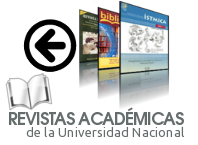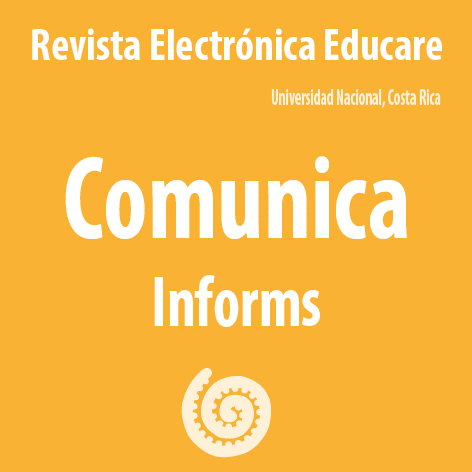Citizen Science in Promoting Chemical-Environmental Awareness of Students in the Context of Marine Pollution by (Micro)Plastics
DOI:
https://doi.org/10.15359/ree.27-1.15845Keywords:
Environmental awareness, Marine Litter, Microplastics, chemistry educationAbstract
Objective. To evaluate how the tasks carried out by the students in the scope of the PVC educational citizen science project for monitoring the quality of coastal waters contributed to raising their awareness of the problems of marine litter, in particular, the pollution of the ocean by plastics and microplastics, and the importance of chemistry in society. Methods. The project stage here presented consisted of six asynchronous tasks, conducted with digital mediation through the Moodle platform. The project took place in the 2018/2019 school year and involved 442 students and nine chemistry teachers from a middle school in the northern coastal region of Portugal. Data on the impact on students’ awareness of the contexts considered were collected from the outputs the students produced in each task. The data were analyzed using the content analysis technique. Discussion. From this analysis emerged indicators of the PVC project’s positive contribution to raising students’ awareness of the pollution of marine environments by (micro)plastics, as well as raising awareness of the role of chemistry in society. The students expressed positive opinions toward this science and recognized its links with other areas of science and technology. Conclusion. Thus, it was found that citizen science projects significantly promote students’ awareness of chemical-environmental subjects by exploring current and relevant contexts.
References
Araújo, J. L., Morais, C., & Paiva J. C. (2021). O potencial pedagógico da ciência cidadã explorado na aula de química através da monitorização da qualidade da água e da presença de microplásticos. Em J. B. Lopes, J. P. Cravino, C. A. Santos, & E. de S., Cruz (Eds.), Relatos e investigação de práticas de ensino de Ciências e Tecnologia (pp. 692-697). Universidade de Trás-os-Montes e Alto Douro. http://vpct2018.utad.pt/wp-content/uploads/2018/12/VPCT2018-Atas-ISBN_2018_12_18_final.pdf
Araújo, J. L., Morais, C., & Paiva, J. C. (2020). Developing and implementing a low-cost, portable pedagogical kit to foster students’ water quality awareness and engagement by sampling coastal waters and analyzing physicochemical properties. Journal of Chemical Education, 97(10), 3697-3701. https://doi.org/10.1021/acs.jchemed.0c00333
Bellocchi, A., King, D. T., & Ritchie, S. M. (2016). Context-based assessment: Creating opportunities for resonance between classroom fields and societal fields. International Journal of Science Education, 38(8), 1304-1342. https://doi.org/10.1080/09500693.2016.1189107
Callaghan, C. T., Rowley, J. J. L., Cornwell, W. K., Poore, A. G. B., & Major, R. E. (2019). Improving big citizen science data: Moving beyond haphazard sampling. PLOS Biology, 17(6), 1-11. https://doi.org/10.1371/journal.pbio.3000357
Cardellini, L. (2012). Chemistry: Why the subject is difficult? Educación Química, 23(2 extraordinario), 1-6. https://doi.org/10.1016/S0187-893X(17)30158-1
Centro de Informação de Residuos. (2015). Tempos de mudança para reduzir o uso abusivo de sacos ambiente. Quercus Ambiente, 10(69), 18-19. https://www.quercus.pt/images/PDF/QA/QA69.pdf
Diário de Notícias. (13 Dezembro 2018). Mar Mediterrâneo Oriental com mais de 410 mil resíduos de plástico – Estudo. https://www.dn.pt/lusa/mar-mediterraneo-oriental-com-mais-de-410-mil-residuos-de-plastico---estudo-10318766.html
Feord, H. (2020). ECSA’s characteristics of citizen science. ECSA, 1-6. https://1-eu--citizen-science.translate.goog/blog/2020/04/30/characteristics-of-citizen-science/?_x_tr_enc=1&_x_tr_sl=en&_x_tr_tl=es&_x_tr_hl=es&_x_tr_pto=sc
Follett, R., & Strezov, V. (2015). An analysis of citizen science based research: Usage and Publication Patterns. PLOS ONE, 10(11), 1-14. https://doi.org/10.1371/journal.pone.0143687
Gulacar, O., Zowada, C., & Eilks, I. (2018). Bringing chemistry learning back to life and society. In I. Eilks, S. Markic, & B. Ralle (Eds.), Building bridges across disciplines for transformative education and sustainability future (pp. 49-60). Shaker. https://www.researchgate.net/publication/327824320_Bringing_Chemistry_Learning_Back_to_Life_and_Society
Harlin, J., Kloetzer, L., Patton, D., Leonhard, C., & Leysin American School high school students. (2018). Turning students into citizen scientists. In S. Hecker, M. Haklay, A. Bowser, Z. Makuch, J. Vogel, & A. Bonn (Eds.), Citizen science: Innovation in open science, society and policy (pp. 410-428). UCLPress. https://doi.org/10.2307/j.ctv550cf2.35
Henderson, L., & Green, C. (2020). Making sense of microplastics? Public understandings of plastic pollution. Marine Pollution Bulletin, 152, 1-15. https://doi.org/10.1016/j.marpolbul.2020.110908
Hidalgo-Ruz, V., & Thiel, M. (2013). Distribution and abundance of small plastic debris on beaches in the SE Pacific (Chile): A study supported by a citizen science project. Marine Environmental Research, 87-88, 12-18. https://doi.org/10.1016/j.marenvres.2013.02.015
Johnstone, A. H. (1991). Why is science difficult to learn? Things are seldom what they seem. Journal of Computer Assisted Learning, 7(2), 75-83. https://doi.org/10.1111/j.1365-2729.1991.tb00230.x
Jornal de Negócios. (08 de Junho de 2018). Em Portugal, 70% do lixo das praias é plástico. https://www.jornaldenegocios.pt/economia/ambiente/detalhe/em-portugal-70-do-lixo-das-praias-e-plastico
Lúcio, S. (05 de maio de 2017). Há plástico no sal que se consome em Portugal. Sábado. https://www.sabado.pt/ciencia---saude/detalhe/20170505-1112-ha-plastico-no-sal-que-se-consome-em-portugal
Lukyanenko, R., Wiggins, A., & Rosser, H. K. (2020). Citizen science: An information quality research frontier. Information Systems Frontiers, 22, 961-983. https://doi.org/10.1007/s10796-019-09915-z
McKeachie, W. J. (1994). Teaching tips. Strategies, research, and theory for College and University Teachers (9th ed.). D.C. Heath.
Mercogliano, R., Avio, C. G., Regoli, F., Anastasio, A., Colavita, G., & Santonicola, S. (2020). Occurrence of microplastics in commercial seafood under the perspective of the human food chain. A review. Journal of Agricultural and Food Chemistry, 68(19), 5296-5301. https://doi.org/10.1021/acs.jafc.0c01209
Önen, A. S., & Ulusoy, F. M. (2014). Developing the context-based chemistry motivation scale: Validity and reliability analysis. Journal of Baltic Science Education, 13(6), 809-820. https://doi.org/10.33225/jbse/14.13.809
Organización para la Cooperación y el Desarrollo Económicos. OECD (2016). PISA 2015 Results (Volume I): Excellence and equity in education. https://doi.org/10.1787/9789264266490-en
Prins, G. T., Bulte, A. M. W., & Pilot, A. (2018). Designing context-based teaching materials by transforming authentic scientific modelling practices in chemistry, International Journal of Science Education, 40(10), 1108-1135. https://doi.org/10.1080/09500693.2018.1470347
Rose D. E. (2012). Context-based learning. In N. M. Seel (Eds), Encyclopedia of the sciences of learning (pp. 799-802). Springer. https://doi.org/10.1007/978-1-4419-1428-6_1872
Sausan, I., Saputro, S., & Indriyanti, N. Y. (2018). Chemistry for beginners: What makes good and bad impression. In Mathematics, Informatics, Science, and Education International Conference (Vol. 157, pp. 42-45). Atlantis Press. https://doi.org/10.2991/miseic-18.2018.11
Serafim, T. S. (21 de Novembro de 2018). O que sabemos sobre os microplásticos na costa portuguesa? Público. https://www.publico.pt/2018/11/21/ciencia/noticia/sabemos-microplasticos-costa-portuguesa-1851764
Swirski, H., Baram-Tsabari, A., & Yarden, A. (2018). Does interest have an expiration date? An analysis of students’ questions as resources for context-based learning. International Journal of Science Education, 40(10), 1136-1153. https://doi.org/10.1080/09500693.2018.1470348
Teixeira, A. S. G. (2018). Marine Litter: Social representations and persuasion in science communication through infographics [Dissertação de Mestrado, Universidade do Porto]. https://repositorio-aberto.up.pt/handle/10216/114329
Tulloch, A. I. T., Possingham, H. P., Joseph, L. N., Szabo, J., & Martin, T. G. (2013). Realising the full potential of citizen science monitoring programs. Biological Conservation, 165, 128-138. https://doi.org/10.1016/j.biocon.2013.05.025
Wang, W., Ge, J., & Yu, X. (2020). Bioavailability and toxicity of microplastics to fish species: A review. Ecotoxicology and Environmental Safety, 189, 1-10. https://doi.org/10.1016/j.ecoenv.2019.109913
Wiggins, A., Bonney, R., LeBuhn, G., Parrish, J. K., & Weltzin, J. F. (2018). A science products inventory for citizen-science planning and evaluation, BioScience, 68(6), 436-444. https://doi.org/10.1093/bioscience/biy028
Wiyarsi, A., Pratomo, H., & Priyambodo, E. (2020). Vocational high school students’ chemical literacy on context-based learning: A case of petroleum topic. Journal of Turkish Science Education, 17(1), 147-161. https://doi.org/10.36681/tused.2020.18
Wood, J., & Donnelly-Hermosillo, D. F. (2019). Learning chemistry nomenclature: Comparing the use of an electronic game versus a study guide approach. Computers & Education, 141, 1-18. https://doi.org/10.1016/j.compedu.2019.103615
Yalmanci, S. G., & Gözüm, A., I., C. (2019). The study of whether receiving a pre-school education is a predictive factor in the attitudes of high school students toward the environment according to their environmental ethics approach. International Electronic Journal of Environmental Education, 9(1), 18-32. https://eric.ed.gov/?id=EJ1201577
Downloads
Published
How to Cite
Issue
Section
License
1. In case the submitted paper is accepted for publication, the author(s) FREELY, COSTLESS, EXCLUSIVELY AND FOR AN INDEFINITE TERM transfer copyrights and patrimonial rights to Universidad Nacional (UNA, Costa Rica). For more details check the Originality Statement and Copyright Transfer Agreement
2. REUTILIZATION RIGHTS: UNA authorizes authors to use, for any purpose (among them selfarchiving or autoarchiving) and to publish in the Internet in any electronic site, the paper´'s final version, both approved and published (post print), as long as it is done with a non commercial purpose, does not generate derivates without previous consentment and recognizes both publisher's name and authorship.
3. The submission and possible publication of the paper in the Educare Electronic Journal is ruled by the Journal’s editorial policies, the institutional rules of Universidad Nacional and the laws of the Republic of Costa Rica. Additionally, any possible difference of opinion or future dispute shall be settled in accordance with the mechanisms of Alternative Dispute Resolution and the Costa Rican Jurisdiction.
4. In all cases, it is understood that the opinions issued are those of the authors and do not necessarily reflect the position and opinion of Educare, CIDE or Universidad Nacional, Costa Rica. It is also understood that, in the exercise of academic freedom, the authors have carried out a rogorous scientific-academic process of research, reflection and argumentation thar lays within the thematic scope of interest of the Journal.
5. The papers published by Educare Electronic Journal use a Creative Commons License:














 The articles published by Educare Electronic Journal can be shared with a Creative Commons License:
The articles published by Educare Electronic Journal can be shared with a Creative Commons License: 



